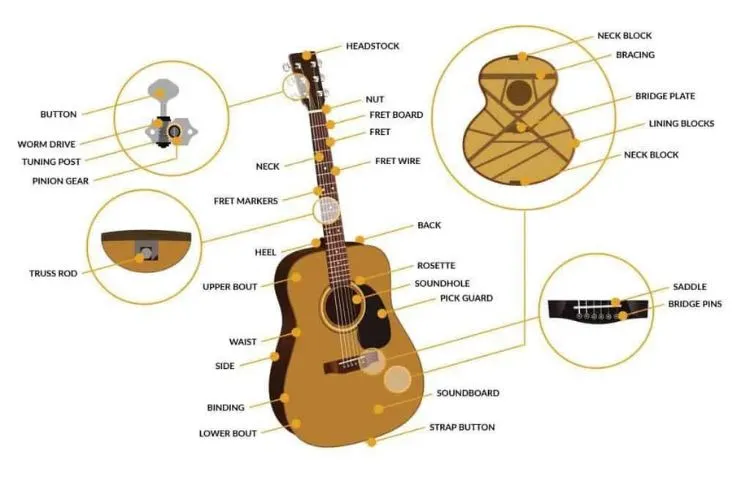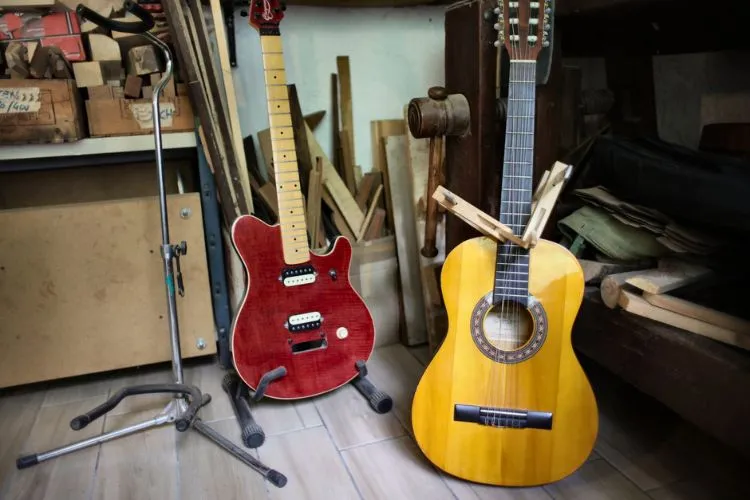When you step into the world of guitars, the variety of sizes can seem vast and complex. Full-size guitars, with their rich sounds and varied styles, are a significant part of this world.
This article dives into how big is a full size guitar, how its size impacts its playability and sound, and the vital factors to consider when choosing one.

Contents
- 1 🎶How Big Is A Full size Guitar?
- 2 🎶Understanding Guitar Sizes
- 3 🎶Anatomy of a Full-Size Guitar
- 4 🎶Acoustic vs. Electric Full-Size Guitar Dimensions
- 5 🎶Factors That Influence Full-Size Guitar Dimensions
- 6 🎶Choosing the Right Guitar Size for You
- 7 🎶Care and Maintenance of Full-Size Guitars
- 8 🎶Pro Tips
- 9 🎶frequently asked question (FAQs)
🎶How Big Is A Full size Guitar?
A full-size guitar typically refers to instruments designed to accommodate adult players, offering a standard scale length and body size that differs between acoustic and electric models.
For acoustic guitars, the scale length (the distance from the nut to the saddle) averages around 25.5 inches (64.8 cm), with body dimensions varying significantly based on the model, such as the Dreadnought or Concert styles.
Electric guitars also often have a scale length of about 25.5 inches, but with slimmer bodies compared to their acoustic counterparts.
The dimensions of a full-size electric guitar’s body are more about shape and design than size, with models like the Fender Stratocaster and Gibson Les Paul being iconic examples. Overall, full-size guitars are designed to offer a balance of playability, comfort, and sound quality suitable for most adult players.
🎶Understanding Guitar Sizes
Guitar sizes can confuse beginners. The size of a guitar is essential as it affects comfort, playability, and sound. Full-size guitars are the largest standard size. But what does “full-size” mean, and how does it compare to other sizes?

The size of a guitar generally refers to its scale length and body dimensions. The scale length is the distance between the nut and the saddle, influencing the spacing between frets. Body dimensions, including width and depth, affect the guitar’s volume and tone.
- Types of Guitars by Size: Guitars come in several sizes: 1/4, 1/2, 3/4, and full-size. Each size suits different age groups and body sizes. Full-size guitars are typically meant for adults and older teenagers due to their larger dimensions.
- Importance of Guitar Size: The size of the guitar you choose should match your body size for comfort and ease of play. Aside from physical comfort, different guitar sizes produce different sounds. Smaller guitars have a softer tone, while full-size guitars have a louder, more resonant sound.
🎶Anatomy of a Full-Size Guitar
Understanding a full-size guitar’s anatomy can help you grasp the influence of its dimensions on playability and sound.

Scale Length
The scale length of a full-size guitar varies between acoustic and electric models. For example, a full-size acoustic guitar often has a scale length of about 25.5 inches, while electric guitars like the Fender Stratocaster also share this scale length. This affects the spacing of frets and overall playability.
Body Dimensions
A full-size guitar’s body dimensions, especially depth and width, define its sound volume and resonance.
Models like the Dreadnought are known for their broad bodies, producing a strong, loud sound. Electric guitars, such as the Gibson Les Paul, have solid bodies that contribute to their sustained, rich tones.
Neck Width and Profile
The neck size impacts how comfortably a guitarist can reach around the neck and fret the strings.
Full-size guitars usually have wider necks, offering more space between strings. This makes them suitable for fingerstyle playing but might challenge players with smaller hands.
Other basic information about guitar: How Many Octaves On A Guitar? | Why Are Guitar Pedals So Expensive?
🎶Acoustic vs. Electric Full-Size Guitar Dimensions
The dimensions of acoustic and electric guitars, while both considered full-size, have distinct characteristics.

Acoustic Guitar Dimensions
Acoustic guitars usually have larger bodies than electric guitars, contributing to their louder, richer sound. The body size, along with the scale length, determines the guitar’s volume and how it resonates.
Electric Guitar Dimensions
Electric guitars have smaller bodies but maintain a similar scale length to acoustics. The body size of an electric guitar affects its weight and how comfortable it is to play, especially when standing.
🎶Factors That Influence Full-Size Guitar Dimensions
Several factors can affect the dimensions of a full-size guitar, from the materials used to its design.
Material and Build
The materials used in a guitar affect its size, weight, and sound. For example, heavier woods can lead to a fuller sound but might increase the guitar’s weight and size.
Guitar Design Variations
Design elements like cutaways affect a guitar’s dimensions and playability. Cutaways allow easier access to higher frets but can slightly alter the instrument’s sound by reducing the body size.
Custom and Signature Models
Custom and signature guitars often have unique dimensions catering to specific needs or preferences of artists. These variations can influence playability and sound.
🎶Choosing the Right Guitar Size for You
Selecting the right guitar size is crucial for comfort and music style.
Body Size and Comfort
Comfort should be a priority when choosing a guitar. A full-size guitar might not suit everyone, especially younger or smaller-framed players. Testing different sizes can help find the most comfortable option.
Sound and Genre Considerations
The size of the guitar also affects its sound. Full-size guitars are versatile, suiting various music genres. The choice should reflect the sound you aim for and the genres you prefer.
Pros and Cons of Full-Size Guitars
Full-size guitars offer a rich sound and are suitable for various music styles. However, their size might be cumbersome for some players, and they often come at a higher price due to the larger amount of material used.
🎶Care and Maintenance of Full-Size Guitars
Proper care extends the life of a guitar.
- Transportation and Storage: Investing in a good case is essential for protecting your guitar. Proper storage prevents damage and keeps the guitar in good condition.
- Setup and Adjustments: Regular setups ensure your guitar plays well. This might include adjusting the action or intonation and is crucial for full-size guitars to optimize playability and sound.
- Long-Term Maintenance: Routine maintenance, such as cleaning and string changing, preserves the guitar’s quality. Regular check-ups can also prevent issues from developing.
🎶Pro Tips
Exploring different guitars is key to finding the perfect one. Remember, a guitar’s size can greatly influence its tone and volume. Consider getting a professional setup to ensure your full-size guitar plays its best.
🎶frequently asked question (FAQs)
Typically, 25.5 inches, though slightly shorter or longer lengths exist depending on the model.
While possible, it might be challenging. Trying a reduced-size guitar might offer more comfort and ease of play.
Yes, classical guitars usually have a shorter scale length and a narrower body compared to other acoustic models.
Yes, the shape can vary without affecting the scale length, influencing the guitar’s sound and playability.
Larger bodies produce louder and fuller sounds, while smaller bodies offer a softer, more controlled tone.
Models like the Fender Stratocaster for electric and the Dreadnought for acoustic are popular choices.
Yes, the size and shape of a guitar can influence your playing comfort and technique.
Conclusion:
Choosing a full-size guitar involves considering several factors, including size, sound, and comfort. Understanding the dimensions and how they affect playability and tone is essential. With the right information, you can select a guitar that suits your needs and enjoy making music for years to come.
